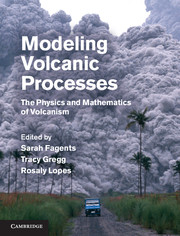Book contents
- Frontmatter
- Contents
- Contributors
- Chapter 1 Introduction
- Chapter 2 Magma chamber dynamics and thermodynamics
- Chapter 3 The dynamics of dike propagation
- Chapter 4 Dynamics of magma ascent in the volcanic conduit
- Chapter 5 Lava flows
- Chapter 6 Unsteady explosive activity
- Chapter 7 Unsteady explosive activity
- Chapter 8 Sustained explosive activity
- Chapter 9 Modeling tephra sedimentation from volcanic plumes
- Chapter 10 Pyroclastic density currents
- Chapter 11 Magma–water interactions
- Chapter 12 Deep-sea eruptions
- Chapter 13 Volcano–ice interactions
- Chapter 14 Modeling lahar behavior and hazards
- Chapter 15 Introduction to quantitative volcano seismology
- Chapter 16 Volcano acoustics
- Chapter 17 Planetary volcanism
- Index
- Plate section
- References
Chapter 13 - Volcano–ice interactions
Published online by Cambridge University Press: 05 March 2013
- Frontmatter
- Contents
- Contributors
- Chapter 1 Introduction
- Chapter 2 Magma chamber dynamics and thermodynamics
- Chapter 3 The dynamics of dike propagation
- Chapter 4 Dynamics of magma ascent in the volcanic conduit
- Chapter 5 Lava flows
- Chapter 6 Unsteady explosive activity
- Chapter 7 Unsteady explosive activity
- Chapter 8 Sustained explosive activity
- Chapter 9 Modeling tephra sedimentation from volcanic plumes
- Chapter 10 Pyroclastic density currents
- Chapter 11 Magma–water interactions
- Chapter 12 Deep-sea eruptions
- Chapter 13 Volcano–ice interactions
- Chapter 14 Modeling lahar behavior and hazards
- Chapter 15 Introduction to quantitative volcano seismology
- Chapter 16 Volcano acoustics
- Chapter 17 Planetary volcanism
- Index
- Plate section
- References
Summary
Overview
This chapter reviews basic physical processes controlling interactions between silicate magmas and surface ice and snow layers, focusing on subglacial, englacial, and supraglacial interactions. Where possible, theoretical considerations are linked with observations of the lithofacies and sequence characteristics of the deposits expected as a result of these various interactions, with particular focus on the products of mafic eruptions. The range of possible interactions is large, resulting in a correspondingly diverse group of resulting landforms. These predictions are made for the environment of the Earth, but with suitable changes to atmospheric temperature and pressure and acceleration due to gravity are readily applicable on Mars. Numerous putative examples of volcano–ice interaction features on Mars have already been documented and this chapter provides a comprehensive unifying theoretical framework for further interpretation of features on both planets.
Introduction
Magma–ice interactions can occur in a number of ways and can produce a range of products and landforms (e.g., Lescinsky and Fink, 2000; Mee et al., 2006; Komatsu et al., 2007; Larsen and Eiriksson, 2008; Smellie, 2009), the details depending on the geometry and timescale of the interaction. No subglacial rhyolite eruptions have ever been observed. A “typical” mafic volcanic eruption progresses from initial rapid subsidence and collapse of the overlying ice surface to form a pit, simultaneous with subglacial emplacement of volcanic products (often but not always pillow lava, forming a pillow mound or ridge) in a water-filled cavity. Many eruptions might cease at this point but, commonly, as the volcanic edifice grows upward and the vent becomes shallower, the magma interacts explosively with the surrounding meltwater and a high subaerial eruption column is generated, accompanied by deposition of abundant ash. This results in the construction of a subaqueous tuff cone or ridge, the latter known as a tindar (Jones, 1969).
- Type
- Chapter
- Information
- Modeling Volcanic ProcessesThe Physics and Mathematics of Volcanism, pp. 275 - 299Publisher: Cambridge University PressPrint publication year: 2013
References
- 6
- Cited by



